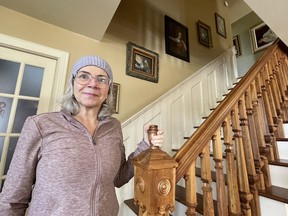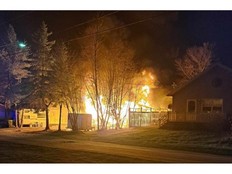Moment of silence for cancer patient who warned of radon dangers
Angela Stief Lea, who was raising awareness after testing revealed her home had high levels of radon, died of cancer

Article content
After being diagnosed with terminal lung cancer in 2023 that she blamed on high levels of radon found in her Havelock home, Angela Stief Lea said her goal was to use her remaining time to save one life.
Last year, she launched an awareness campaign encouraging people to get their homes tested for the odourless, colourless radioactive gas.
Stief Lea died at home on April 18.
A moment of silence was held at a Canadian Association of Radon Scientists and Technologists conference in Moncton on Thursday.
Jeff LeBlanc, a certified radon inspector who had tested Stief Lea’s home, and the association’s vice-president, told the crowd that when his company receives a call for radon testing, the majority of the homeowners say it was because of Stief Lea’s advocacy.
“We’re going to save thousands of lives because of her,” LeBlanc said.
Radon gas comes from the breakdown of uranium in soil and rock. Released outdoors, it is diluted and is not a concern. But in enclosed areas like homes, it can accumulate to high levels and become a health risk, and the leading cause of lung cancer in non-smokers, according to Health Canada.
NB Lung, a New Brunswick health charity, said in a news release that members of the organization were saddened to her about Stief Lea’s death.
“A lifelong health advocate, she raised her voice to warn others of this ‘hidden danger…this odourless, colourless, tasteless gas.’”
At the conference, Melanie Langille, NB Lung’s president and CEO, said her group is urging the provincial government to provide financial supports for New Brunswickers living with naturally occurring radon gas.
Federal guidelines say radon contamination occurs when a home tests higher than 200 Becquerels per cubic metre (200 Bq/m3). Testing can only be done in winter, when windows and doors aren’t open. Natural ventilation dramatically reduces radon buildup.
According to NB Lung, one in four New Brunswick homes have “dangerous levels” of radon.
The gas can enter homes through cracks in foundations, walls, and around window casements and service pipes. Langille said she hears many stories of people who get their homes tested, but are unable to afford to have them repaired to prevent exposure, which can be $2,000 to $3,000 or more to fix.
“We know when people are faced with an affordability crisis they’re faced with right now there are more pressing issues on the minds of New Brunswickers like feeding their families and filling their gas tanks than making these larger investments in their homes that can help prevent something that can seem so far down the road.”
David Inness, president of Canadian Association of Radon Scientists and Technologists, said the goal of the conference is to raise awareness about radon and to facilitate conversations with radon mitigators, researchers, and other organizations.
During the conference he said a challenge was given to the New Brunswick government to come up with a funding methodology to assist the average New Brunswicker in mitigating radon in their homes.
In New Brunswick, homeowners are responsible for the cost of radon testing in their own homes.
We know when people are faced with an affordability crisis they're faced with right now there are more pressing issues on the minds of New Brunswickers like feeding their families and filling their gas tanks than making these larger investments in their homes that can help prevent something that can seem so far down the road.
Melanie Langille, NB Lung
Langille said during pre-budget consultations with the government, she outlined the costs of house repairs and testing, and noted one person with lung cancer could cost the province $70,000 a year for medical care, so prevention was the less expensive route.
“The dollars make sense,” she said.
The budget did not include additional help for homeowners in respect to radon testing.
A 2023 Brunswick News investigation found that the province underspent its budget for radon gas testing and remediation in social housing units by hundreds of thousands of dollars in the 2020/2021 and 2021/2022 fiscal years, despite the auditor general’s call to ramp up efforts because of the potential health risk to tenants.
The investigation also revealed an array of problems with radon gas in PH and RNH units, such as hundreds of units testing far beyond what’s considered safe by Health Canada, a lack of qualified contractors to test for radon and fix problems, and new tenants being moved into contaminated units before remediation work had been done.
As of last spring, one in every four Public Housing and RNH units tested by the government had returned radon levels high enough to be considered contaminated by the feds. Those units have all been remediated, Housing Minister Jill Green had said.
Department spokesperson Kate Wright said in March that 1,578 radon tests were administered for the 2023-24 testing season. The results of those tests are currently being collected and will be available in the coming months.
At Thursday’s conference, Dr. Anne-Marie Nicol, an environmental scientist with the B.C. Centre for Disease Control, spoke about a working group that brings together stakeholders, including the British Columbia minister of health, to work on initiatives related to radon.
The group has been able to facilitate the launch of a free lung cancer screening program for people exposed to high levels of radon, education about radon in schools, and a lending library program for radon detection devices.
Langille said she would like to develop a relationship with the province similar to that in British Columbia.
“We can only do so much,” she said, adding that with provincial support more awareness could be raised in the province, and New Brunswickers could be helped to overcome the costs of testing and repairs.
Brunswick News reached out to the Department of Health, Department of Environment and Local Government for comment but did not hear back.












Postmedia is committed to maintaining a lively but civil forum for discussion. Please keep comments relevant and respectful. Comments may take up to an hour to appear on the site. You will receive an email if there is a reply to your comment, an update to a thread you follow or if a user you follow comments. Visit our Community Guidelines for more information.